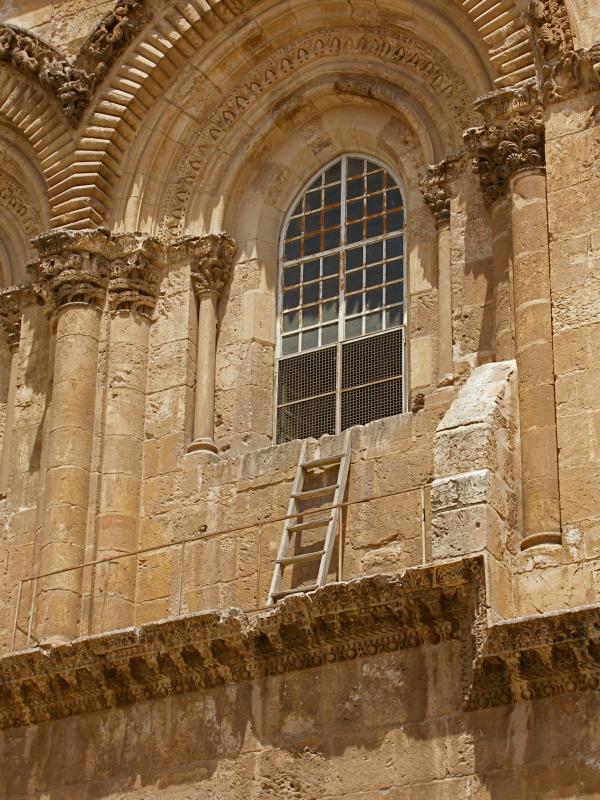
Admittedly, this is one of the more serious arguments covered in this blog. The question of which branch of Christianity gets to manage the tomb of Christ is a serious issue for believers and one which cannot be easily resolved. However, the immovable ladder is one of the more trivial consequences of this conflict, so it should probably be worth covering.
Upon his conversion to Christianity, Roman emperor Constantine sought to commemorate the location of the crucifixion and tomb of Jesus Christ. After finding a location on the edge of Jerusalem, Constantine started building what would become the Church of the Holy Sepulchre on the site of an old Roman temple. Constantine’s church would be destroyed in 614, rebuilt, and destroyed again in 1009, but the Muslims who ruled Jerusalem at the time agreed to let the Byzantine or Eastern Roman Empire rebuild the church, and this church is the one which remains today.

However, given that such a site is holy to most branches of Christianity, which denomination gets to run the shrine is a perpetual matter of dispute. The Crusader takeover of Jerusalem brought the church under Catholic control, the expulsion of the Crusaders by Saladin brought it into Orthodox hands. The Third Crusade led to an agreement to return the church to Catholic control, but this was also short-lived. For centuries, different denominations would pass the church back and forth depending on which side was able to persuade the Ottoman sultan to let them control the church. In 1757, the Greek Orthodox church was given control of most of the shrine by an order of the sultan. However, other denominations were still allowed to worship in their own reserved spaces in the church. Tensions flared up further once the Orthodox Church was allowed to renovate the Church following an 1808 fire. Napoleon III threatened to invade Jerusalem to restore Catholic supremacy at the Church, as the Ottoman Empire was relatively weak, but Nicholas I of Russia rebuffed him by threatening to invade the Ottomans if the French invaded first. In 1853, this conflict led to a final decree stating that whoever controlled a portion of the church at the time would remain in control for perpetuity. This “Status Quo” has remained in place ever since by international agreement, even after the Ottoman Empire’s collapse.
The Immovable Ladder is a prominent symbol of this tenuous peace, having remained in position outside a church window for over 100 years. A ladder was first noted on this spot in the 18th century, and may have been used to provide easy access to the cornice below. However, as it was unclear which denomination placed the ladder there, its ownership under the Status Quo had been ambiguous, hence why none of the Church’s caretakers have moved it. Disagreements between the different denominations over turf have caused major conflicts at the Church even in recent years, so it is understandable why even something which is seemingly as insignificant as a ladder has never been moved in spite of various damages and renovations to the Church. However, the ladder has been moved twice in recent memory. The first time was in 1997 when a traveler pulled it into the church through the window in a prank to show how ridiculous the argument was, which was followed up with by the installation of a grate in front of the window. The second time the ladder was moved was in 2009 for unclear reasons to the adjacent window, though it was quickly returned.

This was a very interesting post to read. I enjoyed learning more about the topic because this is not usually something that I will try to learn about on my own. I especially found it interesting during the paragraph where you stated: “this conflict led to a final decree stating that whoever controlled a portion of the church at the time would remain in control for perpetuity.” Overall, this was a great blog.